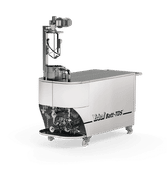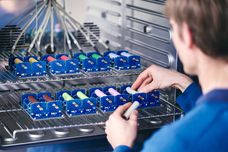Scientists harness the power of pee
Singapore researchers create first battery powered by urine
Advertisement
Physicists in Singapore have succeeded in creating the first paper battery that generates electricity from urine. This new battery will be the perfect power source for cheap, disposable healthcare test-kits for diseases such as diabetes. This research is published in the Institute of Physics' Journal of Micromechanics and Microengineering.
Scientists in research groups around the world are trying to design ever smaller "biochips" that can test for a variety of diseases at once, give instant results, and, crucially, can be mass produced cheaply. But until now, no one has been able to solve the problem of finding a power source as small and as cheap to fabricate as the detection technology itself.
Led by Dr Ki Bang Lee, a research team at Singapore's Institute of Bioengineering and Nanotechnology (IBN) have developed a paper battery that is small, cheap to fabricate, and which ingeniously uses the fluid being tested (urine) as the power source for the device doing the testing.
The chemical composition of urine is widely used as a way of testing for tell-tale signs of various diseases and also as an indicator of a person's general state of health. The concentration of glucose in urine is a useful diagnostic tool for diabetics. The lead researcher, Dr Lee, envisions a world where people will easily be able to monitor their health at home using disposable test-kits that don't need lithium batteries or external power sources.
The battery unit is made from a layer of paper that is steeped in copper chloride (CuCl) and sandwiched between strips of magnesium and copper. This "sandwich" is then held in place by being laminated, which involves passing the battery unit between a pair of transparent plastic films through a heating roller at 120ºC. The final product has dimensions of 60 mm x 30 mm, and a thickness of just 1 mm (a little bit smaller than a credit card).
Writing in the Journal of Micromechanics and Microengineering, Lee describes how the battery was created and quantifies its performance. Using 0.2 ml of urine, they generated a voltage of around 1.5 V with a corresponding maximum power of 1.5 mW. They also found that the battery performances (such as voltage, power or duration) may be designed or adjusted by changing the geometry or materials used. Microengineering.
Reference: K. B. Lee; "Urine-activated paper batteries for biosystems"; J. Micromech. Microeng. 2005, 15, 210-214.
Other news from the department science
These products might interest you
Most read news
More news from our other portals
See the theme worlds for related content
Topic World Battery Technology
The topic world Battery Technology combines relevant knowledge in a unique way. Here you will find everything about suppliers and their products, webinars, white papers, catalogs and brochures.

Topic World Battery Technology
The topic world Battery Technology combines relevant knowledge in a unique way. Here you will find everything about suppliers and their products, webinars, white papers, catalogs and brochures.


































































